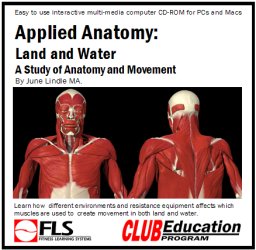
ISBN# 978-1-935746-03-4
Course Description:
Applied anatomical movement can be confusing for any health-fitness professional. This easy to use multimedia course advances your knowledge of basic human movement, muscle use, types of contractions, and the muscle equation for both land and water environments. Deepen your understanding of concentric/eccentric action as it pertains to specific movements and equipment use on land and in water. Gain confidence in understanding the purpose of every exercise you prescribe so you can provide safe and effective programming for your group fitness and one-on-one clients.
Education Level: Intermediate, Advanced
Prerequisites: Basic Knowledge of Anatomy
Successful completion of the quiz is necessary to receive Continuing Education Credit.
Approved for:
| 0.3 | Action Personal Trainer Certification |
| 4.0 | American College of Sports Medicine (ACSM) |
| 0.4 | American Kinesiotherapy Association (COPS-KT) |
| 0.4 | National Association for Fitness Certification (NAFC) |
| 2.0 | National Council on Strength & Fitness (NCSF) |
| 0.5 | National Federation of Professional Trainers (NFPT) |
| 4.0 | National Strength Professionals Association (NSPA) |
| 4.0 | YMCA |
Course Objectives:
After completing this course you will be able to:
- Explain and demonstrate movement in the planes and axes of motion.
- Understand anatomical movement terms.
- Identify and describe movement at the major joints in the body.
- Describe primary muscle actions at the major joints in the body.
- Identify which muscle or muscle group is responsible for a particular movement.
- Understand muscle actions and muscle involvement influenced by gravity on land.
- Understand muscle actions and muscle involvement for submerged movement.
- Be able to effectively use weighted, buoyed, drag, and rubberized equipment in the aquatic environment and on land, identifying muscles targeted by specific movements.
- Explain progressive overload principles for land and water resistance programs.
Other Courses by this author:
System Requirements to View This Course
This course is tablet enabled and can be viewed on an iPad or Android tablet as well as a PC or MAC Computer
